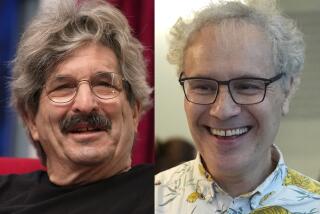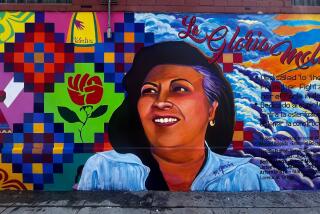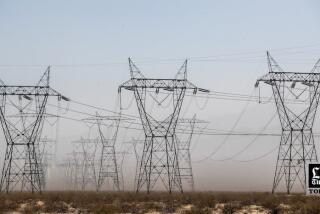Nobel laureate Mario Molina, who helped reveal damage to the ozone layer, dies at 77
- Share via
SAN DIEGO — UC San Diego researcher Mario Molina, who shared the 1995 Nobel Prize in chemistry for helping discover that a class of household chemicals known as CFCs was destroying Earth’s delicate ozone layer, died on Wednesday. He was 77.
Molina, whose work helped lead to the Montreal Protocol, a landmark treaty aimed at repairing damage to the atmosphere, died in Mexico City, according to the Mario Molina Center, an institute that he operated there. The cause of death was not disclosed.
The news came hours after two of his fellow chemists, UC Berkeley’s Jennifer Doudna and French researcher Emmanuelle Charpentier, were awarded the 2020 Nobel Prize in chemistry. It was the first time that two women jointly won that prize.
Molina split his time between Mexico City and UCSD, where he joined the faculty in 2004, providing a boost to a school that was already a world power in atmospheric science.
“He was like a star around which planets circled,” said UCSD Chancellor Pradeep Khosla. “He was an attractor who helped bring a group of great scientists here. He had a sense of gravity, and gravitas.”
Khosla was broadly joined in sorrow Wednesday as news of Molina’s death reached UCSD.
“I have lost my hero. Mother Earth has lost one of her biggest champions,” said UCSD chemist Kim Prather. “He was a true gentleman in every sense.”
Margaret Leinen, director of UCSD’s Scripps Institution of Oceanography, said, “It is especially sad to hear that our Nobel laureate, Mario Molina, passed away today — on the very day on which this year’s Nobel Prize in Chemistry was announced.
“Molina’s prize in chemistry was the first Nobel Prize awarded for work directly on environmental issues. Since then Mario has continued extensive research on aerosols and pollutants but has focused on using his prominence to draw attention to the disparities in the impact of pollutants on the poor and on developing nations.”
Mario José Molina-Pasquel Henríquez was born in Mexico City on March 19, 1943, the son of a lawyer who rose to become an ambassador to several nations.
Like so many researchers who went on to greatness, Molina began early, converting a bathroom into a laboratory when he was only a child. His passion carried him to the National Autonomous University of Mexico, where he earned a bachelor’s degree in chemical engineering in 1965. He went on to UC Berkeley, where he earned a doctorate in physical chemistry in in 1972.
The following year, he took a position as a postdoc under UC Irvine chemist F. Sherwood Rowland in what turned out to be a remarkable pairing of scientists.
They began to study how chlorofluorocarbons — a type of chemical used in such things as hairspray and cleaning supplies — affected the ozone layer. Molina took the lead in the lab, working late into the night on the fifth floor of UCI’s chemistry building.
They quickly realized that they had struck on something important, and scary.
“Just before Christmas in 1973 I turned to my wife [Joan] and said, ‘I think we have found what’s going to cause the end of the world,’” Rowland told the Orange County Register not long after he, Molina and Paul Crutzen won the Nobel in 1995.
Molina and Rowland suspected that CFCs were producing a hole in the ozone layer, allowing an unnatural and unhealthy amount of UV light to reach Earth’s surface.
About nine months later, they published their findings in the journal Nature, shaking the world of science and producing an immediate backlash from chemical companies that produced CFCs. The companies belittled their work. And for a while, there was a lot of doubt about the duo’s findings.
But Molina and Rowland, along with scores of other scientists, later produced additional research that proved CFCs were damaging the ozone layer. Many companies, and some countries, began to curtail their use of the chemicals.
That helped lead to the Montreal Protocol, a 1987 treaty in which nearly 50 countries agreed to help curb CFCs further. Since then, about 150 other countries signed the treaty, which is widely regarded as one of the most meaningful international environmental agreements ever struck.
“The thin ozone layer has proved to be an Achilles heel that may be seriously injured by apparently moderate changes in the composition of the atmosphere,” the Royal Swedish Academy of Sciences said in 1995 in awarding the Nobel to Rowland, Molina and Crutzen.
“By explaining the chemical mechanisms that affect the thickness of the ozone layer, the three researchers have contributed to our salvation from a global environmental problem that could have catastrophic consequences.”
The was not the last of the honors Molina would receive.
In 2013, President Obama awarded him the Presidential Medal of Freedom for what has been described as one of the greatest discoveries in chemistry during the 20th century.
“I was stunned to learn that I’m getting the medal. I’m also very humbled,” Molina told the Union-Tribune not long after meeting Obama at the White House.
“The Nobel is given for work that you do in your field. But the Presidential Medal of Freedom is given for people who are thought to have had an impact on society. This is really an incentive to keep working on the issues that I have been involved with, including climate change.”
Such prizes reflected the work of extraordinary partners, said Don Blake, a UCI chemist.
“Mario was the lab rat and Sherry was the lab director — and they just clicked,” Blake said on Wednesday night. “They came up with this incredible discovery and it never caused competition between them. They knew that their work was the sum of their parts.
“There was mutual respect. They were great together.”
Robbins writes for the San Diego Union-Tribune.
More to Read
Start your day right
Sign up for Essential California for the L.A. Times biggest news, features and recommendations in your inbox six days a week.
You may occasionally receive promotional content from the Los Angeles Times.







